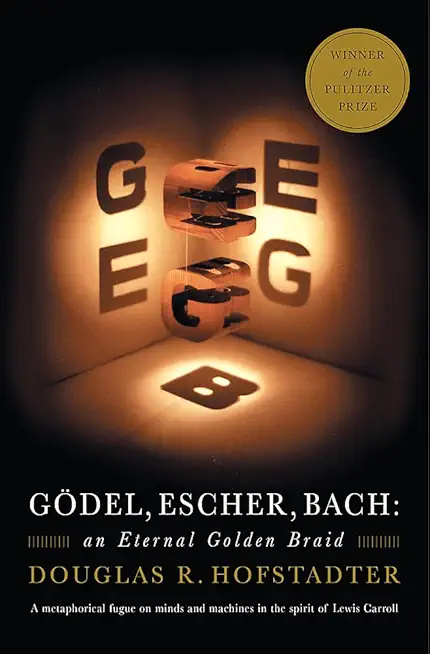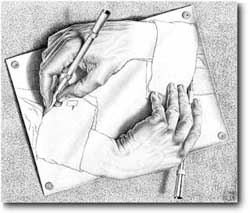
This week has been good. To explain it, I’m going to have to start with my college days. During my undergrad years in El Paso, I was in an extremely conservative congregation. My desire to know God had been subverted, as it is with so many of us, to know “about” God, or more accurately, to know the teachings of a single religious perspective about God and become ever more deeply immersed in it, distrusting everything else.
However, I discovered a wonderful book that kept my mind from being completely nailed shut: Gödel, Escher, Bach: An Eternal Golden Braid, by the mathematician Douglas Hofstadter. Hofstadter’s book was written for the layman, and was entertaining. funny, and delightful. True to the title, he referred frequently to the works of mathematician Kurt Gödel, artist M.C. Escher, and Baroque composer Johann Sebastian Bach. The theme was the principle of what Hofstadter called “strange loopiness”—patterns that turn themselves inside out or strangely embed themselves within themselves, and this was years before the first popular books on chaos theory or fractals would appear.
Hofstadter explained not only what Gödel’s theorem was, but how its principle applied to the world at large. The theorem was a mathematical proof (and when something’s proven in math, it’s proven like nobody’s business) that it is impossible for any arithmetical system to be completely free of contradiction. For instance, in the set of positive integers, 5 – 7 is contradiction. To deal with it, negative numbers had to be created. (Remember when you were a kid how weird negative numbers seemed at first?) Taking it farther, in the realm of real numbers, the square root of a negative number was a contradiction. So enter the imaginaries, as if all numbers weren’t imaginary.
Hofstadter playfully, lovingly, danced open invitations to a universe of contradiction, containing itself and looping back on itself; Möbius strips and Klein pitchers, Escher’s hands drawing themselves into existence, Carroll’s Jabberwockies gyring and gimbling in the wabe of Bach’s cancrizan canons inverting and reversing themselves, Zen koans turning assumptions inside out until there’s no-thing left to know.
After reading G,E,B, I continued as a zealous Fundamentalist for quite some time (before many spiritual morphings), but one thing had changed forever, and that was that I would never be able to fall for the idea that everything could be explained by reason.
Let’s fast forward a couple of decades: On January 22, 2006, I had a glimpse of the nature of the world. Yes, it was unsettling at first, but strangely empowering as well. But it didn’t last long: The actual glimpse was just that—a second or two—and the knowing (as opposed to thinking) of the “empty holodeck” lasted only a few days.
Last Sunday, I found myself missing it. I prayed to be able to see it again, to have a spiritual refresher. Thursday, I saw that Dr. Hofstadter has published a new book: I Am a Strange Loop. I sat down with it a while and saw, to my delight, that he’s taken it to the next logical level: ego, consciousness, identity, and what’s beyond. Hofstadter is one of those gifted with using non-mystical and even non-religious language to teach some of the most sublime realizations.
That night, I dreamt I was on a planet called Cascadia, abundant with mountains, waterfalls and snow. I stayed there a while, but eventually decided to leave, and booked passage on a spaceship. The spaceship somehow became an elevator, and then I realized that Cascadia was inside the Earth, and that all the planets were inside Earth, like nested concentric spheres.
Then I awoke. And I knew that all the worlds are within. Within me, as Thomas Traherne wrote centuries ago, “it’s less that I am in the world, than that the world is within me.”
Let’s talk about it.




 In January, 2006, I had an
In January, 2006, I had an